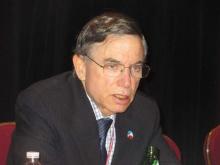NEW YORK – Clinicians have more approved drugs options than ever before for treating children with attention-deficit/hyperactivity disorder, and results from two recently published meta-analyses further document the efficacy of several of these treatments.
The drug treatment algorithm for attention-deficit/hyperactivity disorder (ADHD) now starts with prescribing a stimulant, and for refractory cases follows with an alternative stimulant, and then treatment with atomoxetine (Strattera) , followed by a long-acting alpha-2 agonist (such as guanfacine [Intuniv] or clonidine [Kapvay]), followed by a combination of a long-acting alpha-2 agonist plus a stimulant, Dr. Laurence L. Greenhill said at the psychopharmacology update held by the American Academy of Child and Adolescent Psychiatry.
“I can now cite all these treatments as approved by the FDA [Food and Drug Administration] and as standard of care. There really has been progress” in treating ADHD, said Dr. Greenhill, professor of clinical child and adolescent psychiatry at Columbia University in New York.
A meta-analysis published last year confirmed atomoxetine’s safety and efficacy as monotherapy for treating pediatric ADHD in 25 double-blind, randomized, controlled studies that enrolled a total of nearly 4,000 patients (J. Am. Acad. Child Adolesc. Psychiatry 2014;53:174-87) The results showed a number needed to treat to achieve a clinical benefit of 4, against a number needed to harm to produce an adverse effect of 6, but with serious adverse effects occurring no more often than among patients on placebo. These numbers show both good efficacy and safety for atomoxetine when treating pediatric ADHD, Dr. Greenhill said.
A second meta-analysis published last year assessed the safety and efficacy of long-acting alpha-2 agonists in randomized studies when used either alone (in nine studies) or in combination with a stimulant (in three studies), with a total enrollment in the 12 studies of 2,276 pediatric patients with ADHD (J. Am. Acad. Child Adolesc. Psychiatry 2014;53:153-73). The results showed an effect size for reducing hyperactivity and impulsivity of –0.59 when used as monotherapy and –0.39 when used in combination. As monotherapy the long-acting alpha-2 agonists caused increased fatigue, sedation, and somnolence, as well as more hypotension, bradycardia, and QTc prolongation than did placebo. When used in combination, these drugs caused increased somnolence, hypotension, and bradycardia. Although these results showed that treatment with these drugs require monitoring, the overall safety profile was “very reassuring,” Dr. Greenhill said.
Another notable finding reported last year came from a study of combined treatment with a stimulant and risperidone (Risperdal) for pediatric patients with ADHD and aggression in the Treatment of Severe Childhood Aggression (TOSCA) study. TOSCA randomized 168 patients 6-12 years old with ADHD and either oppositional defiant disorder or conduct disorder to treatment with a stimulant (usually controlled-release methylphenidate) plus parent training, or to the stimulant and parent training plus risperidone.
Six weeks later, patients who received risperidone along with the background treatments had on average a statistically significantly reduced score on the Nisonger Child Behavior Rating Form Disruptive–Total subscale, compared with the patients on the background treatment only, the study’s primary endpoint (J. Am. Acad. Child Adolesc. Psychiatry 2014;53:47-60).
The results “show that this kind of combination treatment can be effective” in this “very well-thought-out study,” Dr. Greenhill said. In addition, the effects from adding risperidone “occurred quickly,” he noted.
Two other notable reports on ADHD last year documented the steadily rising prevalence of the disorder, and the ongoing value from treatment for controlling symptoms. Based on data collected by telephone interviews with randomly selected U.S. adults during 2003, 2007, and 2011, parent-reported history of a diagnosis of ADHD in children aged 4-17 years old increased from 7.8% in 2003 to 11% in 2011, which worked out to approximately 2 million more children with the diagnosis in 2011, compared with 2003 (J. Am. Acad. Child Adolesc. Psychiatry 2014;53:34-46). In 2011, the median age of initial ADHD diagnosis occurred when children were 6 years old.
In another study, 157 patients aged 6-17 years with ADHD and well controlled on treatment with lisdexamfetamine dimesylate (Vyvanse) were randomized to continued treatment or drug withdrawal. Symptoms recurred quickly in most patients, with about 40% meeting the study’s definition of treatment failure by 2 weeks off treatment, and more than 60% having a significant resumption of symptoms by the time they had been off treatment for a month (J. Am. Acad. Child Adolesc. Psychiatry 2014;53:647-57).
Dr. Greenhill is an adviser to BioBehavioral Diagnostics. He has received research support from Rhodes and Shire.
On Twitter @mitchelzoler


